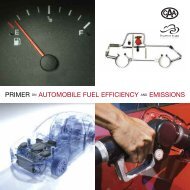Promoting Green Power in Canada - Centre for Human Settlements
Promoting Green Power in Canada - Centre for Human Settlements
Promoting Green Power in Canada - Centre for Human Settlements
- No tags were found...
You also want an ePaper? Increase the reach of your titles
YUMPU automatically turns print PDFs into web optimized ePapers that Google loves.
<strong>Promot<strong>in</strong>g</strong> <strong>Green</strong> <strong>Power</strong> <strong>in</strong> <strong>Canada</strong> Pollution ProbeOn the other hand, feed-<strong>in</strong> tariffs as be<strong>in</strong>gcriticized <strong>for</strong> be<strong>in</strong>g a <strong>for</strong>m of subsidy and <strong>for</strong>rul<strong>in</strong>g out competition, and there<strong>for</strong>e<strong>in</strong>creas<strong>in</strong>g the macroeconomic cost ofrenewable power generation. Whereastender<strong>in</strong>g can deploy new capacities at lowerprices, it results <strong>in</strong> higher adm<strong>in</strong>istrative costsand is <strong>in</strong>effective if it fails to <strong>in</strong>corporate keyconcerns, such as permitt<strong>in</strong>g and worst caseplann<strong>in</strong>g. Furthermore, feed-<strong>in</strong> tariffs createartificial markets that could collapse oncethe tariffs cease to be paid. Germany isprepar<strong>in</strong>g <strong>for</strong> that case with its ecological taxre<strong>for</strong>m, effectively mak<strong>in</strong>g renewable powercheaper and conventional electricity moreexpensive. A phase-out of feed-<strong>in</strong> tariffsseems possible <strong>in</strong> a few years <strong>in</strong> Europe, asthe European Union tries to harmonizesupport structures. Brita<strong>in</strong> and someScand<strong>in</strong>avian countries have seen that apurchase obligation (RPS) offers a betterchance to become a European-wide system.Renewable Portfolio Standards (RPS) arebe<strong>in</strong>g used <strong>in</strong> Brita<strong>in</strong>, Australia and the UnitedStates. Like feed-<strong>in</strong> tariffs, they can create asubstantial and long-term market pull <strong>for</strong>renewable electricity. Texas utilities often opt<strong>for</strong> 10-year contracts that lock <strong>in</strong> renewableenergy generation and the Renewable EnergyCertificates that come with it at fixed prices.While RPS’ are economically efficient, theyautomatically favour the cheapest <strong>for</strong>m ofenergy which, <strong>in</strong> most cases, is w<strong>in</strong>d power.But, as feed-<strong>in</strong> tariffs can be designed to paydifferent tariffs <strong>for</strong> different <strong>for</strong>ms ofelectricity generation, an RPS could alsoconta<strong>in</strong> different technology bands, such asthe Arizona requirement of 50% solar power.Alternatively, subsidies can be used to assistemerg<strong>in</strong>g technologies to obta<strong>in</strong> marketshare, as is be<strong>in</strong>g done <strong>in</strong> the U.K. An RPSneeds to be set at a challeng<strong>in</strong>g level to bemean<strong>in</strong>gful. Examples, such as Texas, showthat sometimes goals are set lower than whatis feasible, which has the potential tohamper renewables deployment <strong>in</strong>stead offoster<strong>in</strong>g it. If tradable certificates are used toimplement an RPS, f<strong>in</strong>ancial <strong>in</strong>stitutionsshould be allowed to use the certificates assecurity aga<strong>in</strong>st loans; otherwise, thisadditional source of <strong>in</strong>come to renewablepower generators may not be recognized ifsuch <strong>in</strong>stitutions view the certificates withskepticism and favour larger generators thatcan f<strong>in</strong>ance projects though equity<strong>in</strong>vestment [HCEAC 2002, p. 35].Provid<strong>in</strong>g priority transmission access torenewable power would ensure that theseprojects can be <strong>in</strong>tegrated <strong>in</strong>to the exist<strong>in</strong>gelectricity grid. Provisions that require gridstrengthen<strong>in</strong>g and l<strong>in</strong>k-ups to be paid by allpower consumers, <strong>in</strong>stead of by the projectowner, would greatly reduce the cost ofrenewable power. Other options would be tolet all energy providers bid <strong>for</strong> transmissionaccess <strong>in</strong> case capacities are restricted (openbidd<strong>in</strong>g), similarly to the U.S. RegionalTransmission Organization approach, <strong>in</strong>which <strong>in</strong>termittent sources can bid <strong>for</strong>transmission access together with othersources <strong>in</strong> day-ahead and real-time markets[FERC 2002, p. 20]. The “pancak<strong>in</strong>g” oftransmission fees (<strong>for</strong> transactions cross<strong>in</strong>gseveral service territories) can create adisadvantage <strong>for</strong> remotely located renewablepower plants and should be avoided.Transmission access has been identified as alikely barrier <strong>in</strong> Ontario s<strong>in</strong>ce energyproviders with larger capacity factors willreceive priority treatment <strong>in</strong> case oftransmission constra<strong>in</strong>t situations undercurrent rules. Where renewable powergeneration is close to exist<strong>in</strong>g grid structures,such grid-embedded power plants canactually improve the security of the overalltransmission system, as opposed to remotegeneration stations [WPTF 2002, p. 10]. The<strong>in</strong>termittency and unpredictability of somerenewable power systems can become amajor disadvantage, but <strong>in</strong>novativemechanisms, such as real-time balanc<strong>in</strong>gmarkets, allow renewable power producersto obta<strong>in</strong> the best value <strong>for</strong> power thatdeviates from the amounts reserved <strong>in</strong>advance [REPP 2002, p. 27].103
















